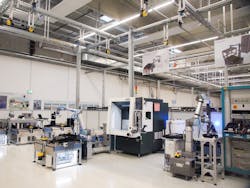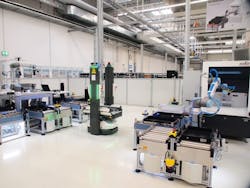Lights-out Manufacturing: Myths Versus Realities
As manufacturing companies consider what the “factory of the future” looks like, autonomous production within a “lights-out” factory seems likely to expand across the industrial spectrum. The concept of a lights-out factory, where the requirements for human activity are so minimal that the facility can operate in the dark, is something of a unicorn: a wonderful idea, but one that is unlikely to materialize any time soon.
That said, the digital and automation technologies needed to make it a reality are now starting to mature, and companies across all industries are being challenged to make products better, faster, cheaper and more sustainably despite supply chain challenges and a shrinking workforce. A dark factory could help not only address sustainability, but also productivity.
Lights-out Factories are Yet to Materialize
It is an ambitious expectation for lights-out production. Traditionally, the type of manufacturing that lends itself to this type of factory is simple mass production on a fixed line layout. As products grow increasingly complex and mass customization/configuration increases the number of potential product variants, implementing a completely dark factory seems to become even more mythical and out of reach.
Although automation and digital manufacturing technologies can help turn the myth into reality, the changes need to be incremental to reap the benefits (especially in brownfield facilities where large capital investments are already in place).
Lights-sparse Factory Floors are More Economically Feasible
According to a Gartner study, by 2025, 60% of manufacturers will have more than two completely lights-out processes in at least one of their facilities. Lights-out manufacturing does not need to be an all-or-nothing proposition. Instead, manufacturers can identify specific processes or areas within a facility where autonomous production is both feasible and valuable. This incremental lights-out implementation, commonly known as lights-sparse implementation, enables manufacturers to balance the return-on-investment (ROI) from automation without the investment typically required for complete transition to a full lights-out factory.
Manufacturing Operations Software is Key to Lights-Sparse Manufacturing
The development and maturity of numerous automated machines and robots, as well as comprehensive and proven manufacturing operations management (MOM) software, is key to creating these lights-out manufacturing cells. New advances in MOM software offerings make it possible to seamlessly orchestrate autonomous production systems through two key capabilities.
The first is the ability to automatically match the operations requirements with the capabilities of the equipment. Software needs to be able to automatically identify available manufacturing resources when a new product is introduced, as well as during an unforeseen shop floor event such as an equipment failure. Second, manufacturing execution, material supply, supply chain and scheduling need to have event-based integration, which will not only ensure the seamless execution of the production process, but also enable continuous optimization and the automated handling of any possible interruptions.
READ MORE: What Comes Next? Industrial Manufacturers Seek Better Pathways
In addition to these key capabilities, MOM software also provides a new user experience. After all, even when talking about lights-out, people will still play an important role in the future of manufacturing. This new user experience contextualizes information from different sources to enable remote decision-making, which could be anything from re-scheduling and re-prioritization of orders to using alternative supplier strategies.
A New Approach to Manufacturing Planning and Machine Engineering
Lights-out manufacturing concepts require a more flexible relationship between product, process and resources than traditional manufacturing. As a result, manufacturing engineers will need to work more abstractly than before, and the way they define constraints will become crucial to leveraging the full potential of an autonomous production system. This, in turn, increases the importance of using simulation early in engineering to support the automated generation and validation of scenarios essential to successful implementation. Adopting this new approach enables the extra level of flexibility and freedom required for the orchestration software to make its own decisions and reach the level of autonomy necessary to turn the lights off.
Strategic Workforce Planning
As manufacturers begin to implement lights-out concepts, the skill requirements for the workforce will change in three aspects. First, in addition to domain and manufacturing know-how, planning engineers will need to acquire the knowledge required to model abstract constraints and dependencies and use simulation tools for validation in their day-to-day work.
Second, shop floor operators will require knowledge of the latest automation technologies to safely operate autonomous machines and be enabled to extend their capabilities. Machine and solution providers also will need to transition from expert systems with specialized knowledge requirements to user-friendly interfaces to allow quick adaptation and extension of a machine’s capability.
READ MORE: Adapting Medical Design in a Virtual World
This will, for example, include the adaptation of robots, maps for automated guided vehicle (AGV) routes, updating material requirements for new products and more. Leveraging the latest IT and low code programming concepts for different automation engineering tasks can help to enable the broader workforce to contribute to the transition.
Third, job enrichment and continuous learning will help manufacturers stay competitive and profitable in the global economy, as they face an ageing workforce and shortages of skilled laborers.
Key Learnings from Fürth
- The experience of the shop floor workforce is critical and must be captured. It is important to include shop floor operations early to digitalize the “institutional knowledge,” including information like specific constraints, best practices, typical failure scenarios, etc.
- It all starts with material transparency and intra-plant logistic processes, which require 100% transparency in the material management down to commissioning and preparation in boxes.
- Automated material transportation, including loading and unloading, tends to be slower, so optimized advanced scheduling can compensate for this and get the system into a profitable range.
- An autonomous system requires an abstract machine interface based on a capability state machine, so it is important to involve the machine suppliers early in the process to ensure a uniform shop floor interface.
Leveraging its learnings from the factory in Fürth, the Siemens Xcelerator portfolio has already implemented fundamental features to support customers throughout their individual journey.
Benefits of Autonomous Production
The main driver for most manufacturers looking into autonomous production concepts is the need to increase productivity, while reducing labor costs despite the associated risk of getting required labor skills at the right time and place to follow changing market demands.
READ MORE: Cleaning up Your Automated Processes
While the autonomous production concepts can address this challenge, it is not their only value. The ability to automatically match and validate every production process of new and existing products—including processes requirements—to available equipment can enable manufacturers to drive important business KPIs such as earlier time-to-market, sustainability and higher resilience.
Additionally, it enables the ability to produce products in different production systems and facilities to support local and sustainable production, as well as a way to compensate for supply chain interruptions.
Nash Chakraborty is director of marketing, Digital Manufacturing and Christian Heck is technical product manager for Siemens Digital Industries Software.
Use Case: Testing lights-out Production Concepts in Fürth
As both a software vendor and a manufacturing company, Siemens recently implemented an autonomous electronic box-built process with a laser, PXI testing, box assembly and final assembly station. All material transportation on the modular shopfloor layout was realized using AGVs. Each station had its own docking stations to load and unload box carriers. Machine loading as well as assembly tasks were realized using universal robots with custom made end effectors.
Every autonomous cell was equipped with latest PLC technology to realize the defined equipment capabilities, including the handling of incoming and outgoing materials and synchronization with the AGV fleet management system, as well as the safe execution of a specific capability such as “Assemble product variant XYZ.” The orchestration of all capabilities, as well as transport, was realized as part of the Siemens Opcenter MES system including an advanced scheduling algorithm for online optimization.
About the Author
Nash Chakraborty
Director of Marketing for Digital Manufacturing, Siemens Digital Industries Software
Nash Chakraborty, director of marketing for Digital Manufacturing at Siemens Digital Industries Software, has over 30 years of experience in helping customers with manufacturing operations management, IoT platforms, and data-driven business transformation.
Christian Heck
Technical Product Manager, Siemens Digital Industries Software
Christian Heck is a technical product manager for Siemens Digital Industries Software. He has more than 20 years of experience in automation engineering and commissioning, as well as in digital manufacturing software.


